By Kim McDarison
The School District of Fort Atkinson Board of Education during a special meeting Thursday, responded to a request from the district’s administrative team for advice about how best to address the district’s $6.8 million deficit, which did not receive funding through an operational referendum request brought before the district’s voters Tuesday.
In the aftermath of Tuesday’s failed referendum, and after much deliberation, board members opted to initiate a process that will likely result in a number of preliminary notices of non-renewal delivered to some members of the district’s staff, district Superintendent Rob Abbott said, “in the next couple of weeks.”
During the hour-long special meeting, board members received a presentation, delivered jointly by Abbott and Director of Business Services Jason Demerath, outlining three options that could be applied to reduce a funding deficit in place after the district’s voters failed to pass a two-part $8 million operational referendum.
Each of the three options offered a combined approach, using a percentage of the district’s fund balance, coupled with employing strategies of attrition across the district through the downsizing of staff and programming.
After listening to the advantages and disadvantages of each option, board members unanimously advised the district’s administrative team to employ Option 2, which, they agreed, when compared to Option 1, offered the best approach to keeping the district’s fund balance viable, while making, by comparison with Option 3, moderately invasive cuts to the district’s staff.
Codification of Thursday’s advisement is anticipated during a special meeting of the board scheduled for Tuesday, April 18.
Opening the presentation and aided by slides, Abbott said he was prepared to provide the board and the larger community with an update of the referendum outcome and offer next steps for the board to consider given that the referendum was not approved. Within his and Demerath’s presentation, Abbott said, along with election results, board members would receive information about the district’s financial position, staffing cuts to-date, learn about areas from where additional cuts could be made, and visit next steps and timelines.

Takeaways from Tuesday’s election
Sharing a slide showing election results across the various precincts within the school district, Abbott said that the district’s operational referendum brought before the voters last November failed by a margin of 6.6%. Tuesday’s referendum question failed by a margin of 15.9%.
“Given that our financial needs are not going away, and we do not have faith that our Legislature will adequately fund public education in the upcoming biennial budget, a need to seek another operational referendum is a known,” he said, adding that state statutes regulate some of the logistics surrounding a school district’s ability to bring a referendum question before voters. Among them, he said, was a provision stipulating that districts only can place referendum questions on the ballots of regularly scheduled elections and may only ask two referendum questions within one calendar year.
Additionally, he said, next November will not include a regularly scheduled election. The district’s next opportunity to place an operational referendum on a ballot will be February 2024, followed by April, 2024, and November 2024. Further, he said, while three election dates exist in 2024, the district would only be able to consider two ballots, citing the opportunity in the spring, and potentially again in the fall.

Closing the deficit through attrition
Demerath next talked about the size of the district’s deficit, noting that projections developed in advance of the referendum showed that, would the referendum fail, the district would be looking to address a $6.8 million gap.
“Knowing the deficit we were facing, we knew that along with the referendum question we still had to right-size our staff to our declining enrollment and make cuts to get through the four years of the referendum that was proposed. So alongside running the referendum campaign, we were also working to fulfill that promise to the community,” Demerath said.
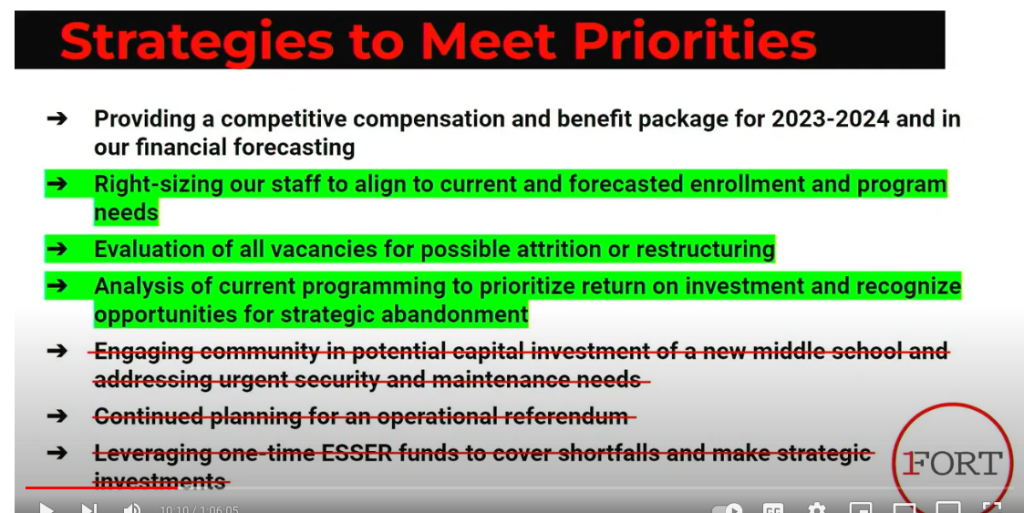
Demerath next talked about strategies used by the district to reduce its deficit, noting among them: “right-sizing our staff to align to current and forecasted enrollment and program needs, evaluation of all vacancies for possible attrition or restructuring, analysis of current programming to prioritize return on investment and recognize opportunities for strategic abandonment.
“These are the ones that we focused on in working to fulfill the promise to the community, making cuts alongside the referendum,” he added.
Other strategies, which, he said, referred to the capital referendum approved by voters in November, and were “no longer in play,” included “an operational referendum and the federal ESSER (Elementary and Secondary School Emergency Relief Fund) funding which has been allocated over the last couple of years.”

Demerath said the district began making budgetary cuts a year ago as it prepared to bring an operational referendum before the voters.
This year, he said, through attrition and restructuring, budgetary changes in the amount of $539,652 was saved by leaving unfilled several positions, including those of one full-time elementary classroom teacher, one full-time math interventionist, one full-time high school math teacher, one full-time high school technology education teacher, one full-time middle school technology education teacher, one full-time middle school librarian and one full-time library support person.
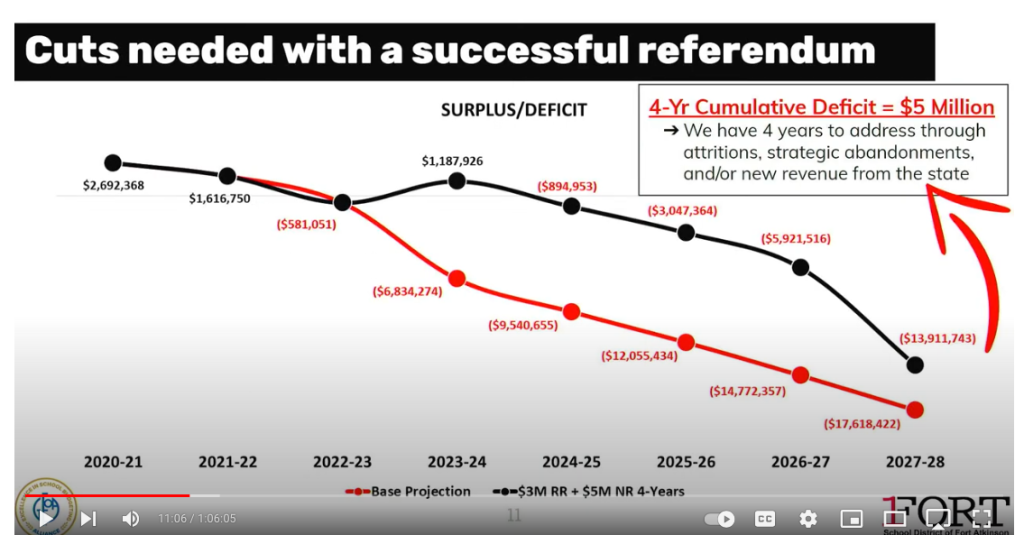
“As the board considered referendum options, we knew that to make it through the four years of an operational referendum, we would have to come up with the cumulative total of $5 million in cuts through attrition, strategic abandonment or new revenue from the state,” Demerath said, adding that a strategy used by the district to close the funding gap included offering a retirement incentive to certified and support staff to allow for positions to be removed through attrition, rather than having to lay people off.
“This is the work we have been doing since January,” he said.
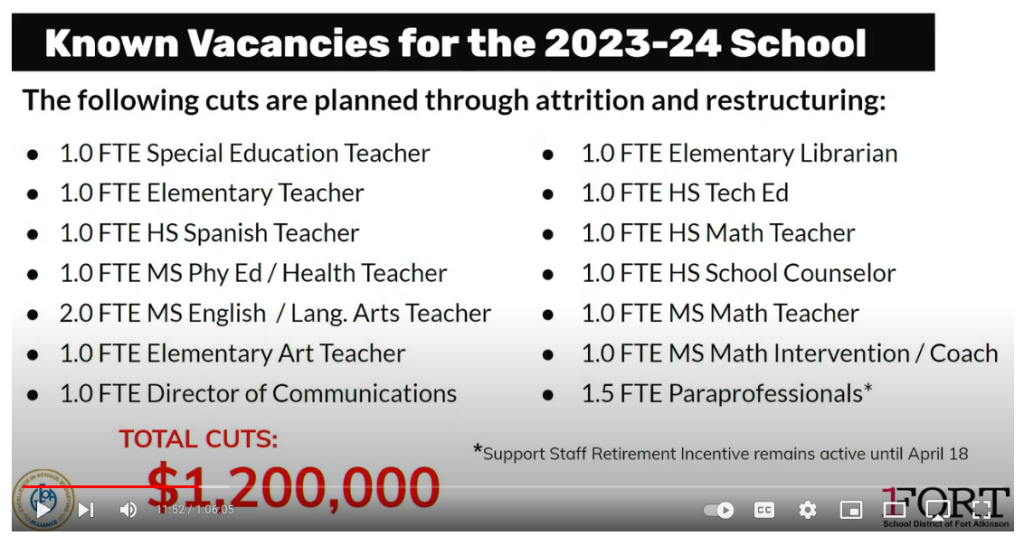
Aided by a slide, shown above, Demerath pointed to some 15 positions which, he said, through retirements and resignations, have been cut by attrition for the 2023-24 school year, saving some $1.2 million.
“These were not shared as cuts prior to this evening, as we were awaiting the outcome of the referendum to verify that these vacant positions were the most strategic ones to attrition for the district to achieve the expectation that we avoid layoffs and save $5 million over the next four years,” Demerath said.
In addition, he said, the support staff retirement incentive window will remain open until April 18.
Positions that will not be filled next year include those of a special education teacher, elementary teacher, high school Spanish teacher, middle school physical education teacher, middle school English teacher, elementary school art teacher, a director of communications position, an elementary school librarian, a high school tech ed teacher, a high school math teacher, a high school counselor position, a middle school math teacher, a middle school math intervention coach, and paraprofessionals, according to a slide.
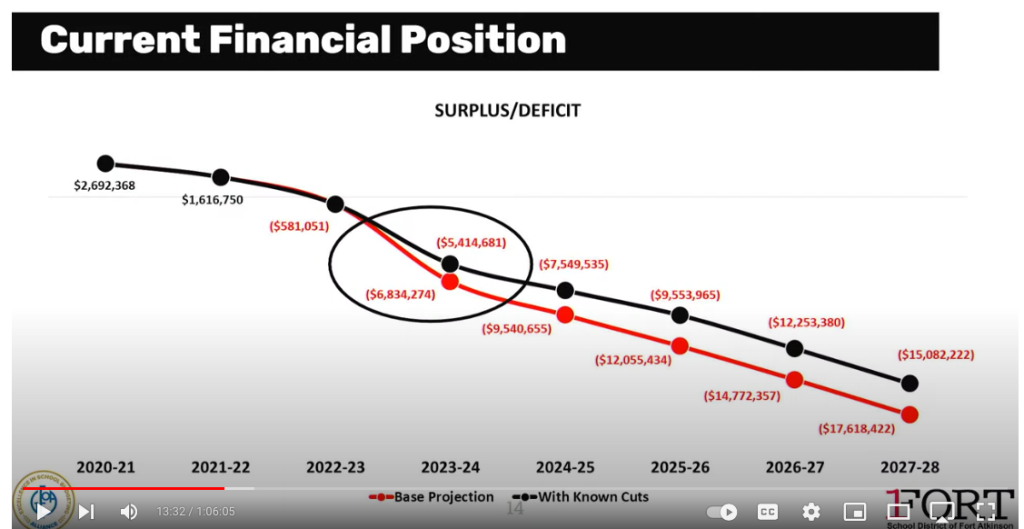
Pointing to a slide, shown above, Demerath said: “You can see here that through the $1.2 million in cuts as well as negotiated health insurance renewal that was lower than what was projected, we decreased the projected deficit for next year by over $1.4 million.”
Demerath next subtracted the $1.4 million is savings from the earlier predicted $6.8 million deficit to arrive at a new deficit amount of $5.4 million for which, he said, a set of strategies would need to be developed.
“As was mentioned earlier, a referendum prior to next spring to address this deficit is not possible. So outside of additional funding from the state to increase districts’ revenue, the only way to manage this $5.4 million deficit for next year is on the expense side,” he said.
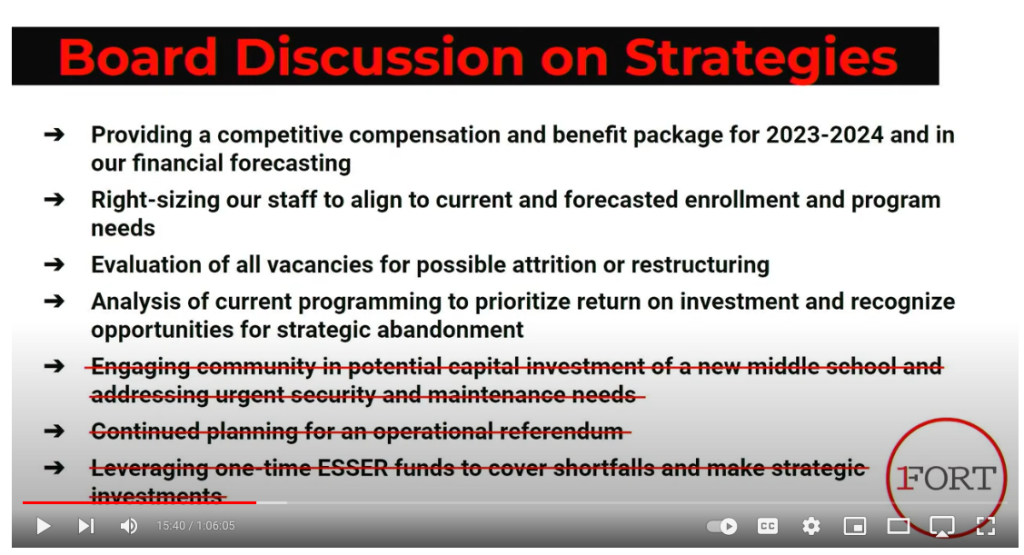
Three options
“We will move next to provide the board with potential options to consider to provide us guidance as to how you would like us to move forward given our impending budget shortfall. The increasing lack of support for an operational referendum since November signals to us that our community wants us to reduce programming, and wants us to reduce services even more. While there may be various reasons for decreased support for additional operating funds, the bottom line is that without those funds we cannot provide our current level of programming and services, and, therefore, the nearly 16-point spread in votes tells us that further cuts are needed,” Abbott said.
Describing the options, Abbott said Option 1 employed known cuts and the use of the district’s fund balance; Option 2 offered additional cuts and a lesser use of the district’s fund balance, and Option 3 offered cuts beyond those suggested in Option 2.
Abbott said that when employing an option, the administrative team will engage several strategies, including: “providing a competitive compensation and benefit package for 2023-24 and in our financial forecasting, right-sizing our staff to align to current forecasted enrollment and program needs, evaluation of all vacancies for possible attrition or restructuring, and analysis of current programming to prioritize return on investment and recognize opportunities for strategic abandonment.”
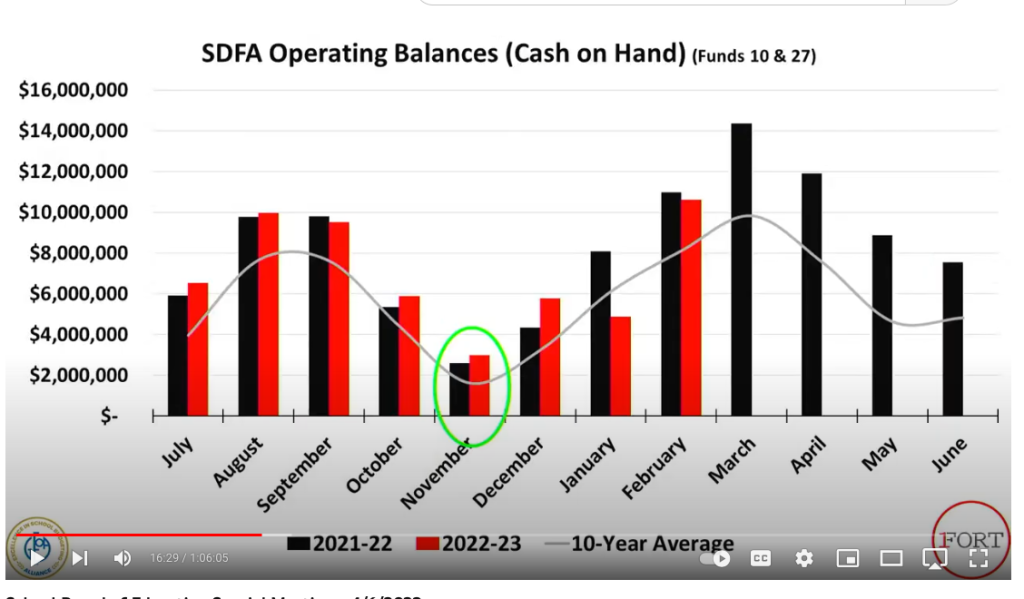
What is a fund balance?
Demerath defined a fund balance as “like someone’s saving account.”
He said the monies were set aside to meet unforeseen expenses, strategic future investment, and, as in the district’s case, “to meet cash flow needs throughout the year based on when our revenue is received.”
Pointing to an “operating balance” graph, shown above, Demerath said it showed monies coming into the district through its revenue sources on a monthly basis.
“What is highlighted here is our low point in cash reserves in the year. Because our two main sources of revenue are state aid and taxes, the timing of receiving funds from those two sources dates how we utilize our operating reserve or fund balance. Because taxes are not collected until December and sent to the district until January, we are over six months into our fiscal year before we see a dime of our budgeted taxes for the year. On the state aid side, we receive a payment in September for a quarter of our annual aid amount, but then do not receive the next payment until early December. Therefore, between the start of the school year and the beginning of December, we utilize our fund balance to cover our operating expenses over those first three months of the school year,” he said.
Pointing to information supplied by the Wisconsin Department of Instruction, Demerath said that a fund balance should hold “an amount sufficient that short-term borrowing for cash flow could be avoided and would also allow the district to set aside sufficient assets to realize its longer range goals.”
“The short-term borrowing comes in based on the cash flow issues I just shared. In order to avoid short-term borrowing, our fund balance at the end of the year would need to be in the $10 million range,” he said.
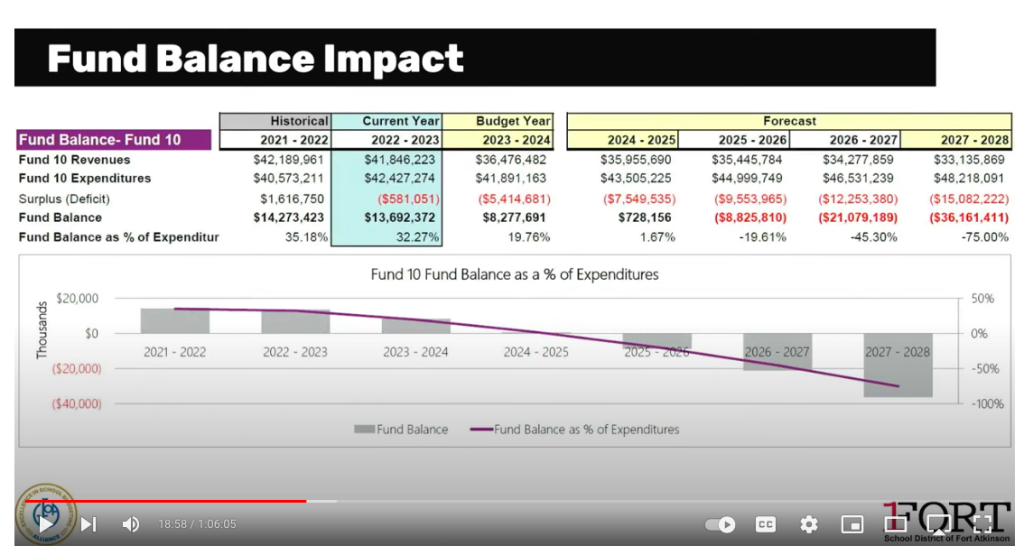
Pointing to a slide, shown above, Demerath said: “This graphic illustrates where our fund balance stood in the beginning of this year and where it would stand at the 2023-24 school year should the total $5.4 million remaining deficit for next year be addressed through the use of fund balance.
“As is highlighted here, with no additional cuts, the end of next year, fund balance would be just over $8.3 million or $1.7 million short of that $10 million mark needed to avoid short-term borrowing.
“If we look one year further, if no additional cuts are made, and no future operational referendum is secured, we would expend nearly all of our fund balance by the end of the 2024-25 school year, leaving us with no funds to cover operational shortfalls or emergency expenditures.”
Option 1
As outlined by Abbott, Option 1 makes use of cuts of $1.2 million, which, he said, were already planned in through attrition and restructuring. Still, he said, would the board choose the option, additional funding developed through an operational referendum would be necessary in 2024.
“Given that no additional cuts would be made in this option, this option will require the largest operational referendum dollar amount in 2024,” he said, noting that from a staffing perspective, the option would not necessitate any active layoffs of employees. Other impacts would include some increased class sizes, and movement of students between elementary schools; reassignment of staff duties; significant use of the fund balance, including one-time funds, to meet the remaining deficit, and short term borrowing for operational expenses.
Option 2
Abbott noted that Option 2 would include cuts and impacts as outlined in Option 1, along with additional cuts up to $1.7 million for a total of $2.9 million for next year.
“The option responds to the community direction to reduce operating costs and will necessitate an operational referendum in 2024 for long-term viability, however the amount of that referendum would be reduced from Option 1 due to those additional operational cuts,” he said.
Abbott said Option 2 would require active layoffs of staff members, staffing impacts as outlined in Option 1, and additional reductions in course offerings and programming, and significant reassignment of staff duties across all employee groups.
Additionally, he said, the option brought the potential to avoid short-term borrowing and the associated costs by maintaining a fund balance within the $10 million range.
“As strategies are enacted under this option, there will likely be other impacts,” he said.
Option 3
According to Abbott, Option 3 would enact elements as proposed within Options 1 and 2, as well as make additional cuts beyond the earlier proposed $2.9 million.
He described the option as a “stronger response to the direction received by the community through Tuesday’s failed referendum.”
Even with those cuts, he said, unless the state opts to fund more fully operational costs associated with schools, an operational referendum in Fort Atkinson would still be necessary in 2024.
“Just like Option 2,” Abbott said, “this option will require active layoffs of staff and would also be more significant, based on the amount the board determines for us to cut, which would result in a significant reduction in course offerings, eliminating programs, high class sizes, and much larger implications for restructuring.
“While this option would have the least impact on the fund balance, it would also begin to compromise our ability to meet our strategic plan goals.”
Board discussion
In response to the presentation, school board member Chris Rogers asked: “If we took Option 3, … then we wouldn’t have to use any of the fund balance?”
Demerath said the amount taken from the fund balance using Option 3 would be dependent upon how much above the $2.9 million in cuts the board would want to go. He said, using Option 3, the board could conceivably request the full $5.4 million to be cut without using fund balance monies this year.
Rogers said he believed the district had been able to avoid short-term borrowing in recent years.
Demerath agreed, saying that he thought there was some short-term borrowing in 2013.
“When we paid off a note to the WRS (Wisconsin Retirement System), we short-term borrowed for less than a month to cover that short time in November,” he said.
Rogers asked about debt.
Demerath said the district recently borrowed $16.5 million to begin $22 million worth of projects, and also held some remaining debt from a $3.2 million borrowing to fund energy projects at the high school.
School board President Kory Knickrehm asked if the district had engaged in short-term debt prior to the WRS payment Demerath had earlier mentioned.
Demerath said he believed that early in his predecessor’s term, which, he said would have been in the 1980s, the district had short-term debt, describing it as “quite a bit.”
Board members worked through the numbers presented within the three options.
After some discussion, there was consensus developed around avoiding short-term borrowing and dipping too deeply into the fund balance.
Board member Rhona Buchta called the balance between the options “a double-edged sword.”
She applauded the board’s desire to remain fiscally-minded, but cautioned about leaning too heavily on cuts that could negatively impact the district’s ability to educate its students.
She asked about changes impacting staff members, such as reassignments, increased work loads, and changes in job descriptions, among others.
Abbott said he though all of those possibilities remained on the table.
“In general, I think that you would see some teachers in different positions than they are now, or their support staff in other positions than they are now, or other parts of the organization. I think that you could see some supervisory duties that are being reallocated from support staff to perhaps certified staff situations. I think you could see some service model changes for student supports moving to different staff than they are currently allocated to. I think that list sort of continues depending on where those cuts are made,” Abbott said.
Buchta asked about plans to meet students’ needs and which resources would remain available to them.
Said Abbott: “I would say that most people who work in the organization would contend that we weren’t over staffed to begin with. Whether or not that’s accurate, I suppose, is up for debate, frankly. The $1.2 million of known cuts that we described for you this evening, you can see the volume of people that it takes in order to obtain the number of $1.2 million. So, in addition to that list, $1.7 million, you know you can sort of get an idea of volume there. I don’t think that making additional cuts like that would come with anything other than additional work spread for others across the organization.”
Board member Robynn Selle asked about the potential for making cuts in ways that did not include losing personnel. With Option 2, she calculated a possibility of needing to layoff some 20 additional members of staff.
Abbott cautioned board members not to wade too deeply into specific numbers, but instead to concentrate on advising the administrative team about which option, in their thinking, offered the best course. He said administrative staff would use that guidance to develop strategies and work to obtain the required numbers.
Still, he said, “Simply put, when 80% of an organization’s costs are based on salaries and benefits, which all schools are for the most part, that’s where most of it is going to land.”
Abbott said a selection of Options 2 or 3 would bring “significant reductions and active layoffs of staff over the next couple of weeks.”
Additionally, he said, “Of our staff that are remaining, we need to make sure that we continue to be a workplace that they want to be in and that our families aren’t choosing educational opportunities elsewhere, which we know is possible for people, so there’s nothing leading in the comment, other than hoping the public understands that as well because it’s a competitive market that we’re in, and as we know, customers are easier to lose than they are to gain.”
Abbott said the district would need to start “doing staff non-renewals” in the next two weeks.
Board members each advised the district’s administrative team in favor of Option 2.
Offering a timeline of events, Abbott said preliminary notices of non-renewal would require board approval by April 20. Final notices of non-renewal would require board approval by early May.
The board would need to take action on the first set of measures during a special meeting set for Tuesday, April 18, at 4:30 p.m. A second special meeting was scheduled for Monday, May 8 at 4:30 p.m.
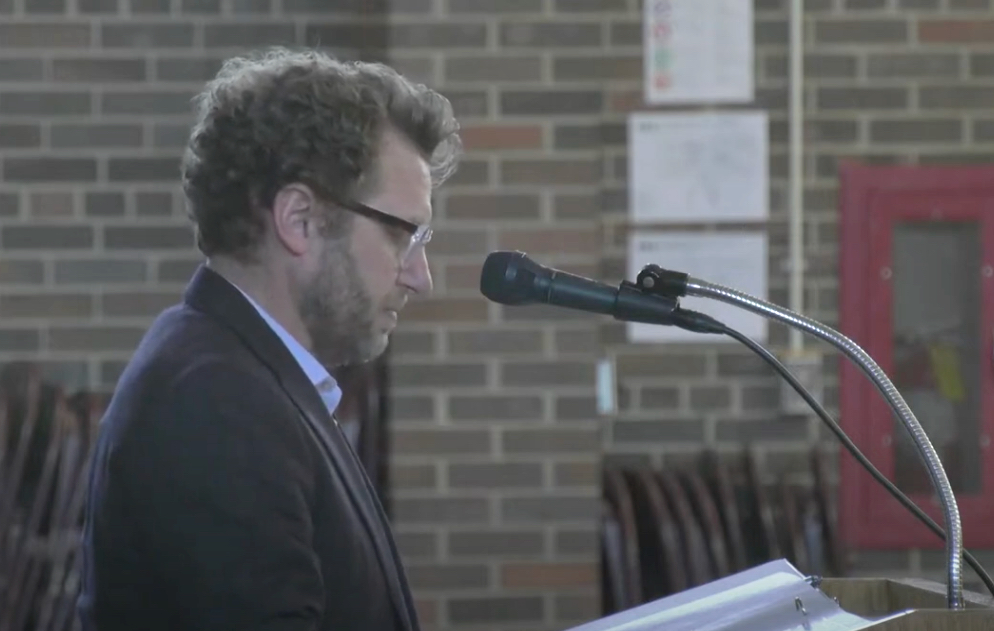
School District of Fort Atkinson Superintendent Rob Abbott addresses the district’s board of education during a special meeting held Thursday to discuss the outcome of Tuesday’s election. During the meeting, the district’s administrative team sought advice from board members about options which could be used to close the $6.8 million funding deficit facing the district after an $8 million operational referendum was not approved by voters. Screen shot photo.
This post has already been read 5386 times!